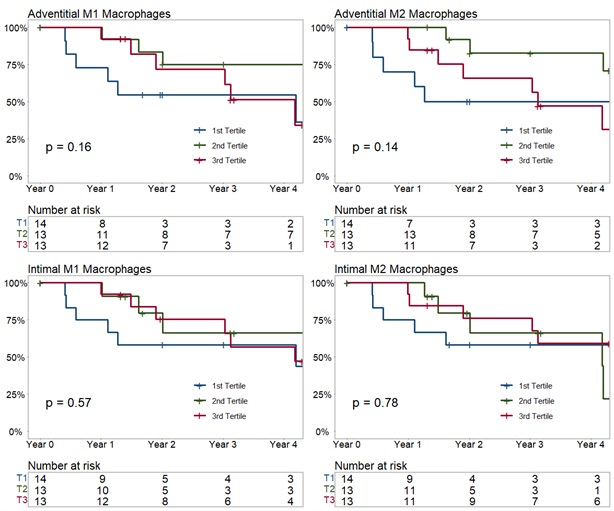Session Information
Date: Monday, November 18, 2024
Title: Vasculitis – Non-ANCA-Associated & Related Disorders Poster III
Session Type: Poster Session C
Session Time: 10:30AM-12:30PM
Background/Purpose: Macrophages play a central role in the pathogenesis of giant cell arteritis (GCA), but few studies have correlated macrophage phenotype or topography from temporal artery biopsy specimens with clinical outcomes. This project aimed to identify associations between the development of vascular damage and the location or functional profile of macrophages in temporal artery biopsy specimens.
Methods: Patients from the Vasculitis Clinical Research Consortium (VCRC) Longitudinal Study of GCA with linked temporal artery biopsy specimens in the VCRC Tissue Repository were included. Temporal artery tissue was stained using immunofluorescent antibodies to CD3 (T Cells), CD4 (T cells), FoxP3 (T Regs), CD68/CD86 (inflammatory “M1” macrophages), and CD68/CD163/CD206 (remodeling “M2” macrophages) using an Opal 7-Color Automation IHC Kit. The relative proportions of these cell types as a percent of the total number of cells in the adventitia and intima were calculated. Associations between macrophage location (adventitia, intima) and phenotype (M1 or M2) and the Large-Vessel Vasculitis Index of Damage (LVVID) were evaluated using t testing and the Kaplan-Meier estimate.
Results: 40 patients had biopsy specimens available for analysis. The average age was 69.9 years (standard deviation [SD] 9.1), all patients were white, and 21/40 (52.5%) male. The mean LVVID score was 1.4 (SD 2.2) at baseline; a minority of patients developed progressive damage over the first year of observation (4/40, 11.4%, mean follow up time 314 days, SD 118 days). In unadjusted analysis there was no association between the developing new damage on the LVVID within the first year of observation and the relative abundance of intimal M1 macrophages (1.8% vs. 0.7% developed damage, p = 0.12), adventitial M1 macrophages (2.0% vs 1.2% developed damage, p = 0.53), intimal M2 macrophages (2.9% vs. 1.4% developed damage, p = 0.37), or adventitial M2 macrophages (3.7% vs. 2.4% developed damage, p = 0.61). There were also no associations identified for CD3+ or CD4+ T cells, but the relative abundance of adventitial FoxP3+ (TReg) cells was associated with developing damage (2.8% vs. 1.0% developed damage, p = 0.04). When the analysis period was extended from the first year of observation to include the entire observation period, half of patients developed damage (20/40, 50%, mean follow up time 1,109 days, SD 962 days. In unadjusted analysis over the entire observation period, there were no additional associations identified between developing damage and either macrophage location (intima or adventitia) or phenotype (M1 or M2). A time to event analysis using a Kaplan-Meier estimate supported these findings (Figure).
Conclusion: Macrophage topography and phenotype from temporal artery biopsy specimens are not associated with the development of damage in patients with GCA.
To cite this abstract in AMA style:
Putman M, Khalidi N, Langford C, Koening C, Pagnoux C, Cuthbertson D, McAlear C, Merkel P. Clinicopathologic Associations Between Macrophage Location and Functional Profile in Giant Cell Arteritis [abstract]. Arthritis Rheumatol. 2024; 76 (suppl 9). https://acrabstracts.org/abstract/clinicopathologic-associations-between-macrophage-location-and-functional-profile-in-giant-cell-arteritis/. Accessed .« Back to ACR Convergence 2024
ACR Meeting Abstracts - https://acrabstracts.org/abstract/clinicopathologic-associations-between-macrophage-location-and-functional-profile-in-giant-cell-arteritis/

